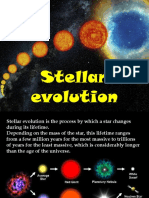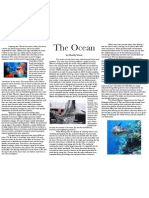Supernovae (Clayton, Uhl)
Supernovae (Clayton, Uhl)
Uploaded by
Catie WootenCopyright:
Available Formats
Supernovae (Clayton, Uhl)
Supernovae (Clayton, Uhl)
Uploaded by
Catie WootenCopyright
Available Formats
Share this document
Did you find this document useful?
Is this content inappropriate?
Copyright:
Available Formats
Supernovae (Clayton, Uhl)
Supernovae (Clayton, Uhl)
Uploaded by
Catie WootenCopyright:
Available Formats
ASTRONOMY PROJECT BIBLIOGRAPHY
SUPERNOVAE
By Jack Clayton and
Caleb Uhl
What Is A Supernova?
A supernova is the explosion of a star at the
end it’s life. The supernova can become billions of
times brighter than the star before it and at maximum
brightness can actually outshine an entire galaxy. It
expels a huge amount of mass, exceeding ten times
the mass of the star before the supernova, which
creates a massive shock-wave. This shock-wave
sweeps up an expanding shell of gas and dust which
forms supernova remnant. Supernovas can occur
in two different ways. Either a type one, or a
type two supernova. The Crab Nebula:
The Crab Nebula (above) is what is
Type Two Supernova: remaining from a massive star that
ended it’s life with a supernova. This
Type One Supernova: A type two supernova is a
result of when a star much supernova occurred almost one
Type one supernovas bigger than the sun dies and thousand years ago when chinese
occur in binary stars. A causes an explosion. When astronomers recorded it in 1054 in the
binary star is two stars the core burns out and the
constellation of Taurus. There is a
that are very close to star dies it releases great
forces of energy. In type II neutron star, or a pulsar, at the core of
each other and orbit
around each other. One supernovae, mass flows into the nebula that is rotating rapidly,
of the stars is much the core making it larger
energizing electrons that are emitting
smaller than the other and causes it to explode.
Because it cannot even radiation. The Crab Nebula is about
star. The smaller star is
called a white dwarf star. withstand its own weight. 6,500 light-years away from Earth and
In a type one supernova Neutrons are the only thing 5 light-years across.
a white dwarf pulls mass that can stop the implosion.
from another star very But when this happens
close to it and when it matter bounces off the hard
reaches about 1.4 times iron in the cold and it turns
as big as the sun it the implosion into an
explodes. Type I explosion.
supernovae show
hydrogen lines while type
II supernovae don’t show
hydrogen lines.
What Is Left Behind
After A Supernova?
After a supernova many different
What Is Left Behind
After A Supernova?
After a supernova many different
things can be created with the energy and
matter the explosion expels. Sometimes a
supernova leaves behind a small but very
dense star made up of almost all neutrons
or elementary particles called neutrons.
This star is called a neutron star. When a
neutron star becomes magnetized it rotates
rapidly. This is a pulsar. Other times, the
supernova creates an invisible object
called a black whole, which has an
incredibly powerful gravitational pull. Even
light can not escape the clutches of the
black hole. It is believed that supernovas
created heavy elements like iron, gold, and
uranium.
You might also like
- MELCs (Biology 1 & 2)Document5 pagesMELCs (Biology 1 & 2)Sab Ibarreta91% (11)
- Aerodynamic Race CarDocument1,255 pagesAerodynamic Race CarJulio MurielNo ratings yet
- Oxygen Plant ManualDocument54 pagesOxygen Plant Manualmahaveen89% (19)
- Physics 8A Syllabus (Introductory Physics) : Wgolightly@berkeley - EduDocument2 pagesPhysics 8A Syllabus (Introductory Physics) : Wgolightly@berkeley - EduSaba HaileNo ratings yet
- SupernovaDocument7 pagesSupernovaAndreaNo ratings yet
- Black Hole & SupernovaDocument24 pagesBlack Hole & SupernovaandreasaryasatyaNo ratings yet
- SupernovaDocument3 pagesSupernovaexxaiter333No ratings yet
- BlackholeDocument4 pagesBlackholeJENNIFER FORTUNo ratings yet
- Supernovae Nasa Imagine ArticleDocument1 pageSupernovae Nasa Imagine Articleapi-26963416No ratings yet
- SupernovaDocument2 pagesSupernovaveena bhatNo ratings yet
- ErumDocument9 pagesErumIrshad SheikhNo ratings yet
- Association Between Supernova Remnants and PulsarsDocument16 pagesAssociation Between Supernova Remnants and PulsarsGadhadar ReddyNo ratings yet
- Stars and Contellations 1Document13 pagesStars and Contellations 1api-410254072No ratings yet
- Stellar EvolutionDocument13 pagesStellar EvolutionJayeeta DasNo ratings yet
- Spectral Type Mass (Xsun) Surface Temperature (K) Luminosity (Xsun) Radius (Xsun)Document3 pagesSpectral Type Mass (Xsun) Surface Temperature (K) Luminosity (Xsun) Radius (Xsun)mir696100% (1)
- The Cataclysm of SupernovaDocument4 pagesThe Cataclysm of SupernovaVincent S RyanNo ratings yet
- Honours Course in Space ScienceDocument17 pagesHonours Course in Space ScienceGadhadar ReddyNo ratings yet
- Example 2Document16 pagesExample 2oscar.feng2No ratings yet
- STARSDocument21 pagesSTARSNicolás Muñoz GarcíaNo ratings yet
- Supernova - WikipediaDocument27 pagesSupernova - WikipediaYn FoanNo ratings yet
- Stellar EvolutionDocument9 pagesStellar EvolutionSliezyyNo ratings yet
- English AssignmentDocument4 pagesEnglish AssignmentBrylle Jairus LacamenNo ratings yet
- Mechanism of SupernovaeDocument15 pagesMechanism of SupernovaeNived ChristopherNo ratings yet
- Star Formation ArticleDocument4 pagesStar Formation Articlemarkjayrecto17No ratings yet
- The Life Cycle of A Star - World General Knowledge SeriesDocument3 pagesThe Life Cycle of A Star - World General Knowledge SeriesRida khan khanNo ratings yet
- Document 22Document2 pagesDocument 22almazanandrew2No ratings yet
- Type Ia SupernovaDocument22 pagesType Ia Supernovasipobey750No ratings yet
- Types of SupernovaeDocument7 pagesTypes of SupernovaeYusranNo ratings yet
- ©1999 Sky Publishing Corp. All Rights Reserved.: August 1999Document8 pages©1999 Sky Publishing Corp. All Rights Reserved.: August 1999Davor BatesNo ratings yet
- Outer SpaceDocument3 pagesOuter Spacemeilan.lanie82No ratings yet
- SuperNova Essay - Completed Spring Semester of 2021Document6 pagesSuperNova Essay - Completed Spring Semester of 2021Cloud SurgeonNo ratings yet
- The Life Cycle of A StarDocument24 pagesThe Life Cycle of A StarNica Joy AlcantaraNo ratings yet
- The Variable StarsDocument17 pagesThe Variable StarsMorales, Jerome R.No ratings yet
- Black Holes: The Story of Collapsing Stars. First Edition. Pankaj S. JoshiDocument20 pagesBlack Holes: The Story of Collapsing Stars. First Edition. Pankaj S. Joshiarshivaji100% (1)
- Grey Modern Chronology History InfographicDocument1 pageGrey Modern Chronology History Infographicrarokylechester15No ratings yet
- What Is A SupernovaDocument3 pagesWhat Is A Supernovaapi-3825233No ratings yet
- Supernova and PulsarsDocument15 pagesSupernova and PulsarsGadhadar ReddyNo ratings yet
- SupernovaDocument17 pagesSupernovaapi-286215473No ratings yet
- Space: The UniverseDocument9 pagesSpace: The UniverseIshita SharmaNo ratings yet
- Mass of A StarDocument15 pagesMass of A StarMark Jhudiel VillarealNo ratings yet
- HTRTHRTTJDocument5 pagesHTRTHRTTJHEHENo ratings yet
- Pulsar Stars (Space)Document12 pagesPulsar Stars (Space)Krish_666No ratings yet
- NebulaDocument31 pagesNebulashaluNo ratings yet
- Seven Ages of StarlightDocument26 pagesSeven Ages of Starlightaljun0910505No ratings yet
- Supernova: Nova (Plural Novae) Means "New" inDocument16 pagesSupernova: Nova (Plural Novae) Means "New" inlyn_celzNo ratings yet
- SupernovaDocument14 pagesSupernovaveena bhatNo ratings yet
- Stellar Evolution - The Birth, Life, and Death of A StarDocument2 pagesStellar Evolution - The Birth, Life, and Death of A StarKaiNo ratings yet
- Life Cycle of StarsDocument3 pagesLife Cycle of StarsDanah GaaNo ratings yet
- How Do Stars Form in A Nebula?Document2 pagesHow Do Stars Form in A Nebula?sttiching video roothikaNo ratings yet
- Astronomy L-6Document45 pagesAstronomy L-6brianquino14No ratings yet
- Neutron StarDocument3 pagesNeutron StarAtif AadeezNo ratings yet
- Bstellar RevolutionDocument24 pagesBstellar RevolutionTrisha MagtibayNo ratings yet
- Physics 35 Stellar EvolutionDocument46 pagesPhysics 35 Stellar Evolutionarjel galvanNo ratings yet
- Chandra Harvard Edu Pdf5Document6 pagesChandra Harvard Edu Pdf5shaniladwiNo ratings yet
- 5 Stages in The Death of A StarDocument2 pages5 Stages in The Death of A StarJoan Vianney Clare JudayaNo ratings yet
- Science 9 - ConstellationsDocument4 pagesScience 9 - ConstellationsJOSHUA CABIGAYANNo ratings yet
- Supernovae - IBDP Physics HL FE2016 - Kognity-Part 4-4Document11 pagesSupernovae - IBDP Physics HL FE2016 - Kognity-Part 4-4onur yavuzcetinNo ratings yet
- Life Cycle of A Star The Schools' ObservatoryDocument1 pageLife Cycle of A Star The Schools' Observatoryelijahalilquirido26No ratings yet
- Constituents and StructuresDocument18 pagesConstituents and StructuresHassan BareachNo ratings yet
- Cbl-Threshold #2-Stars-And-ElementsDocument54 pagesCbl-Threshold #2-Stars-And-ElementsBarangay TalisayNo ratings yet
- Life Cycle of A Star NotesDocument10 pagesLife Cycle of A Star NoteslyraNo ratings yet
- Death of StarsDocument0 pagesDeath of Starshotrdp5483No ratings yet
- Astronomy Review Session: Fasten Your Seat Belts and Get Ready For The Ride!Document25 pagesAstronomy Review Session: Fasten Your Seat Belts and Get Ready For The Ride!marsennekendall5945No ratings yet
- 2b Supernovae SummaryDocument2 pages2b Supernovae SummaryCatie WootenNo ratings yet
- Life On The MoonDocument6 pagesLife On The MoonCatie WootenNo ratings yet
- NNNNNNEEEEEBUUUUULAAAAAAADocument1 pageNNNNNNEEEEEBUUUUULAAAAAAACatie WootenNo ratings yet
- Gengras ORourke Summary PaperDocument1 pageGengras ORourke Summary PaperCatie WootenNo ratings yet
- Drake TheoryDocument1 pageDrake TheoryCatie WootenNo ratings yet
- 2B - Black HolesDocument1 page2B - Black HolesCatie WootenNo ratings yet
- Always ColdDocument2 pagesAlways ColdCatie WootenNo ratings yet
- 2B - Black Hole BibilographyDocument2 pages2B - Black Hole BibilographyCatie WootenNo ratings yet
- Costello, Knoll, MillerDocument3 pagesCostello, Knoll, MillerCatie WootenNo ratings yet
- KameishaMerrillKing EclipsesDocument2 pagesKameishaMerrillKing EclipsesCatie WootenNo ratings yet
- 2B MoonwaterDocument1 page2B MoonwaterCatie WootenNo ratings yet
- Grasslands Cover About 30 Percent of The Earth's Surface. TheDocument3 pagesGrasslands Cover About 30 Percent of The Earth's Surface. TheCatie Wooten100% (1)
- Eric Deerwester, 5bDocument2 pagesEric Deerwester, 5bCatie WootenNo ratings yet
- Wood. OceanDocument1 pageWood. OceanCatie WootenNo ratings yet
- Boreal ForestsDocument2 pagesBoreal ForestsCatie WootenNo ratings yet
- Processing of Edible Oil (Palm Oil)Document32 pagesProcessing of Edible Oil (Palm Oil)Salihah AbdullahNo ratings yet
- презентаціяDocument7 pagesпрезентаціяПетрук ЄгорNo ratings yet
- Worksheet No.3 in PHYSICS 1Document9 pagesWorksheet No.3 in PHYSICS 1Joshua DellosaNo ratings yet
- TERSA EARTH AnalysisDocument6 pagesTERSA EARTH AnalysisSebastian MazoNo ratings yet
- SOHAM International - Conference 20081 PDFDocument256 pagesSOHAM International - Conference 20081 PDFSushmit SharmaNo ratings yet
- Ecology Report: Sarakki Lake: By: Group 8Document4 pagesEcology Report: Sarakki Lake: By: Group 8Naina AgarwalNo ratings yet
- Chapter 4 (Atoms and Atomic Theory)Document47 pagesChapter 4 (Atoms and Atomic Theory)Raynan TabaldoNo ratings yet
- CSEC Geography - Weather and ClimateDocument12 pagesCSEC Geography - Weather and ClimateVanaeAlexander100% (4)
- 551 2nd Edition PDFDocument206 pages551 2nd Edition PDFsumonbdNo ratings yet
- Alternatives, Mitigation and Environmental Management PlansDocument49 pagesAlternatives, Mitigation and Environmental Management Plansmiguel villanuevaNo ratings yet
- Fortis Memorial Research Institute Distribution of Area: Site PlanDocument4 pagesFortis Memorial Research Institute Distribution of Area: Site PlanVIKAS KASHYAP100% (1)
- Physics Study GuideDocument12 pagesPhysics Study Guidebmack21No ratings yet
- Pokropivny 2007Document4 pagesPokropivny 2007vasanthanilNo ratings yet
- WLO Burner-Final Year ProjectDocument37 pagesWLO Burner-Final Year ProjectsscribNo ratings yet
- LEM 91-161 Fla E 0612Document13 pagesLEM 91-161 Fla E 0612Julen IturriozNo ratings yet
- Literature Review FinalDocument13 pagesLiterature Review FinalZile HumaNo ratings yet
- Control of Substances Hazardous To Health (COSHH)Document38 pagesControl of Substances Hazardous To Health (COSHH)ghada gattouchNo ratings yet
- Lesson Plan in StoichiometryDocument7 pagesLesson Plan in StoichiometryLoreen Jane AbogadoNo ratings yet
- Carnot CycleDocument6 pagesCarnot CycleJohn TruckerNo ratings yet
- Methodologies For Environmental EducationDocument15 pagesMethodologies For Environmental EducationJimbo NilloNo ratings yet
- Social Housing in Paris, France: Photo: G. KaltDocument5 pagesSocial Housing in Paris, France: Photo: G. KaltIulia PetreNo ratings yet
- Characteristics of LifeDocument30 pagesCharacteristics of LifeLexis MakabaliNo ratings yet
- How Do Clouds FormDocument6 pagesHow Do Clouds FormSehrishNo ratings yet
- Type of DamsDocument20 pagesType of DamsFaisal EmirNo ratings yet
- Chemistry Module 1Document11 pagesChemistry Module 1angelo aquinoNo ratings yet







































































































